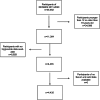Association of serum uric acid with hypertriglyceridemia in children and adolescents: a cross-sectional study
- PMID: 38915087
- PMCID: PMC11194951
- DOI: 10.1186/s12944-024-02182-1
Association of serum uric acid with hypertriglyceridemia in children and adolescents: a cross-sectional study
Abstract
Background: Uric acid (UA), a liver-derived metabolite, is intimately tied to metabolic disorders. Although ample research underscores its connection with hypertriglyceridemia (HTG), studies focusing on adolescents remain limited. To fill the gaps in epidemiology,this study focused on analyzing the relationship between the levels of uric acid and HTG in a demographic sample comprising adolescents from the United States.
Methods: In this study, a total of 4,435 participants through the National Health and Nutrition Examination Survey (NHANES) from 2011 to 2020. The exposure variable was serum uric acid (SUA), the effect variable was HTG, and the covariates included demographic, questionnaire, physical examination and laboratory indicators. We utilized weighted logistic regression and meticulous subgroup evaluations to discern the intrinsic link between SUA and HTG. Stratified analyses augmented the validation of this association, while smooth curve fitting probed for potential nonlinear correlations.
Results: The study included 4,435 participants. Male adolescents exhibit elevated SUA levels. After adjusting for all variables, the weighted multiple logistic regression model revealed that SUA was positively correlated with HTG risk (OR = 1.006, 95% CI: 1.005-1.007). This relationship was consistent across the three tertiles group of SUA (T1: OR = 1.006 [95% CI: 1.005-1.007]; T2: OR = 1.006 [95% CI: 1.005-1.007]; T3: OR = 1.004 [95% CI: 1.003-1.006]; P for trend < 0.001). Stratified analyses confirmed that the positive correlation between SUA and HTG risk was significant, irrespective of sex, age or race.
Conclusions: In American children and adolescents aged 12 to 18 years, there was a pronounced association between SUA and HTG. SUA could serve as a risk indicator for HTG. It is recommended that children diagnosed with HTG should be regularly tested for SUA levels. In addition, it is recommended that SUA be included in the comprehensive care of children diagnosed with HTG.
Keywords: Adolescent; Children; Hypertriglyceridemia; NHANES; Serum uric acid.
© 2024. The Author(s).
Conflict of interest statement
The authors declare that they have no known competing financial interests or personal relationships that may affect the work reported herein.
Figures





Similar articles
-
The association between serum uric acid and hypertriglyceridemia: evidence from the national health and nutrition examination survey (2007-2018).Front Endocrinol (Lausanne). 2023 Jul 18;14:1215521. doi: 10.3389/fendo.2023.1215521. eCollection 2023. Front Endocrinol (Lausanne). 2023. PMID: 37534213 Free PMC article.
-
Association between serum uric acid and cardiometabolic syndrome: a cross-sectional study from NHANES 1999-2020.BMC Cardiovasc Disord. 2025 May 30;25(1):419. doi: 10.1186/s12872-025-04884-5. BMC Cardiovasc Disord. 2025. PMID: 40448045 Free PMC article.
-
Relationship between serum uric acid levels and periodontitis-A cross-sectional study.PLoS One. 2024 Sep 27;19(9):e0310243. doi: 10.1371/journal.pone.0310243. eCollection 2024. PLoS One. 2024. PMID: 39331593 Free PMC article.
-
BMI mediates the association of serum uric acid with bone health: a cross-sectional study of the National Health and Nutrition Examination Survey (NHANES).BMC Musculoskelet Disord. 2024 Jun 19;25(1):482. doi: 10.1186/s12891-024-07595-8. BMC Musculoskelet Disord. 2024. PMID: 38898434 Free PMC article.
-
Associations of serum uric acid with total and cause-specific mortality: Findings from individuals and pooling prospective studies.Atherosclerosis. 2020 Mar;296:49-58. doi: 10.1016/j.atherosclerosis.2019.07.019. Epub 2019 Jul 20. Atherosclerosis. 2020. PMID: 32032905
Cited by
-
High serum uric acid levels are associated with increased prevalence of gallstones in adult women: a cross-sectional study based on NHANES.Front Med (Lausanne). 2025 Jan 17;12:1487974. doi: 10.3389/fmed.2025.1487974. eCollection 2025. Front Med (Lausanne). 2025. PMID: 39897593 Free PMC article.
-
U-Shaped association between apolipoprotein A1 and serum uric acid levels in patients with osteoporotic fractures: a cross-sectional study.Front Endocrinol (Lausanne). 2025 Apr 22;16:1540879. doi: 10.3389/fendo.2025.1540879. eCollection 2025. Front Endocrinol (Lausanne). 2025. PMID: 40331144 Free PMC article.
References
MeSH terms
Substances
Grants and funding
LinkOut - more resources
Full Text Sources
Medical

